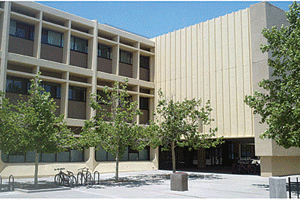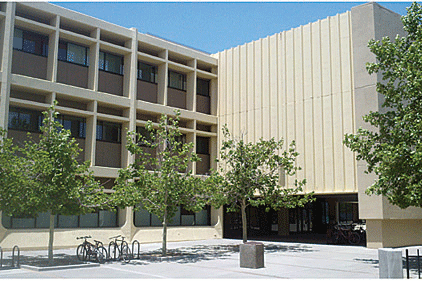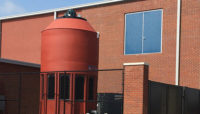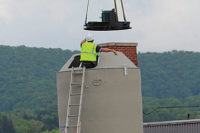
|
| The fan on this plastic cooling tower installed in this Los Angeles office building runs off a VSD and runs slower, consuming less energy. |
spiraling upwards to 116°F in the Los Angeles basin. The heat was far above the normal highs, which would typically be in the mid-70s.
Naturally, the fierce heat combined with high humidity would be a considerable challenge to maintaining the air conditioning in buildings of all types, but that was particularly the case in office buildings, where tenants can be particularly sensitive to uncomfortable temperatures.
Happily for the tenants of an LAX Airport Center office building, the cooling tower that works in conjunction with the building’s HVAC chillers had just been replaced. So, rather than having to endure the sweltering heat, the tenants remained cool and comfortable in their offices.
“This was a very fortunate situation,” says Pat McGuire, sales manager of Centrifugal Technologies, Inc. (Azusa, CA), a longtime air conditioning specialist who worked with L.A.T. Investment Corporation, the owner of 5777 West Century Boulevard, on the new tower design and specifications.
A 16-story, 500,000-sq-ft structure built in 1982, the office complex was originally equipped with injector cooling towers.
“This was a conventional system design back in the 1980s,” McGuire explains, “but over time, the injectors can corrode and clog, causing performance and maintenance problems.”
TO REPLACE OR UPGRADE?
As a mechanical contracting HVAC specialist, McGuire often evaluates newer cooling tower designs for both new and replacement installations. “We felt that a newer type of cooling tower, designed with a shell of engineered plastic, would be more efficient and less maintenance-intensive for the application than simply replacing the old injector system with a new one,” McGuire says.
The engineered plastic cooling tower, developed by Delta Cooling Towers, has been used in industrial and commercial applications of many types because of its inherent resistance to corrosives as well as its high-efficiency features.
Because the 5777 West Century Boulevard building was located near Los Angeles International Airport, it was exposed to the corrosive effects of industrial effluents, jet fuels, and the nearby Pacific salt air. Those corrosive effects in conjunction with prevailing high humidity were undoubtedly contributing to the increasingly waning performance of the building’s old injector cooling tower system. McGuire was convinced that the Delta plastic model would be best for this application.
“I like the Delta design,” he says. “The double-wall plastic shell is impervious to UV light, pH, or corrosives, so it’s very low in maintenance. The tower operates well in high humidity. The shell has a 15-year warranty, which is unique in the cooling tower industry. Also, I think it’s got strong price advantages.”
The model that McGuire recommended was a single, 500-ton Delta TM series cooling tower to replace the old injector tower. The high-efficiency TM Series is an induced draft, counter flow design that is modular, and capable of providing from 250 to over 2,000 cooling tons.
The cooling tower fan runs off a VSD, so the fan runs slower, consumes less energy, and creates less wear and tear on the motors. In office building applications, the variable-speed fan gradually starts in the morning as the weather warms, typically running at 30% until it shuts off in the evening.
GOING WITH THE NEW TECHNOLOGY
Still, there was the matter of convincing building management and ownership that switching to a new cooling tower technology was the right thing to do.
“Centrifugal Technologies had serviced our cooling towers and chillers for about 20 years, so we had a lot of faith that Pat’s recommendation was solid,” says Barron Lowery, the building’s chief engineer. “The main factor that convinced us that we should go with the engineered plastic cooling tower was the avoidance of unhappy tenants. Plus, we learned that if we replaced the old cooling towers with the newer technology, we would have lower operational costs and could avoid the need to replace the tower for quite a bit longer,” he added.
Lowery says that because the new Delta tower promised higher efficiency, he would avoid the need to engage the backup system during peak demand periods in the middle of the day. “That would save us money and save on energy consumption. So, it was the green thing to do, and we decided to go with it,” he says.
And a few weeks after installation, when the uncharacteristic heat wave hit the Los Angeles basin, the new cooling tower was put to an extreme test.
“It performed very well,” Lowery says. “In fact, I would say it exceeded everyone’s expectations. And the tenants all stayed perfectly comfortable.



